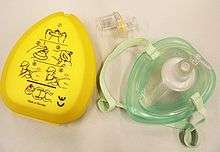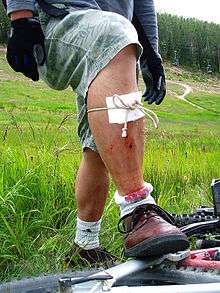First Aid/Protective Precautions
< First AidIntroduction — Issues in Providing Care — Primary Assessment & Basic Life Support — Secondary Assessment — Circulatory Emergencies
Respiratory Emergencies — Soft Tissue Injuries — Bone & Joint Injuries — Environmental Illness & Injury
Medical Conditions & Poisoning — Advanced Topics — Appendices — Meta content
Awareness of Danger
The first thing that anyone providing first aid should be aware of when entering a situation is the potential for danger to themselves. This is especially important in first aid, as situations which have been dangerous to others carry an inherent risk of danger to those providing first aid.
Danger consists of:
- Environmental danger - A danger in the surroundings, such as falling masonry, broken glass, fast vehicles or chemicals.
- Human danger - Danger from people at the scene (including the victim) which can be intentional or accidental.
Barrier Devices
Keeping yourself protected is the first priority of any first aider. The key is to always be aware of your surroundings and the situation, and be alert for any changes therein.
Once you are aware of the hazards, you can then take steps to minimize the risk to oneself. One of the key dangers to a first aider is bodily fluids, such as blood, vomit, and urine, and feces, all of which pose a risk of cross contamination. Body fluids and feces can carry infections and diseases, including, but not limited to, HIV and hepatitis.
Gloves

The main tool of the first aider to avoid this risk is a pair of impermeable gloves. Gloves protect the key contact point with the victim (i.e. the hands) and allow you to work in increased safety. They protect not only from bodily fluids and feces, but from any dermatological infections or parasites that the victim may have.
The first thing a first aider should do when approaching, or on their way to, a victim is to put on their gloves.
Remember GO to the victim (Gloves On) They are generally of three types:
- Nitrile - These gloves can come in any color (often purple or blue) and are completely impermeable to bodily fluids and feces. These are the gloves most recommended for use during victim contact. This material is also rated for dealing with chemical spills. If you ever need to deal with chemical burns, these are the gloves to use (you can brush off dry chemicals with gloved hands if you use nitrile). Nitrile gloves, however, are also the most expensive.
- Latex - Usually white gloves, often treated with powder to make them easier to get on or off. These are not used as widely as they once were due to a prevalence of allergies to latex. Latex allergies are rarely life-threatening; if you must use latex gloves, ask the victim if they have a severe allergy to latex.
- Vinyl - Vinyl gloves are found in some kits; they should not be used for contact with body fluids or feces, though they are far better than nothing. They should primarily be used for touching victims who do not have external body fluids or feces due to the glove's high break rate. For this reason, some organizations recommend that they not be kept in first aid kits due to the risk of confusion.
CPR Adjunct

The other key piece of protective equipment that should be in every first aid kit is an adjunct for helping to perform safe mouth-to-mouth resuscitation.
With mouth-to-mouth resuscitation, there is a high probability of bodily fluid contact, especially with regurgitated stomach contents and mouth borne infections. A suitable mask will help to protect the rescuer from infections the victim may carry (and to some extent, protect the victim from the rescuer). It also makes the performance of CPR less onerous (not wishing to perform mouth to mouth is a key reason cited for bystanders not attempting CPR).
CPR adjuncts come in a variety of forms, from small keyrings with a nitrile plastic shield, up to a fitted rescue 'pocket mask' complete with oxygen inlet, such as the one pictured.
Other equipment
Larger first aid kits, or those in high risk areas could contain additional equipment such as:
- Safety glasses - Prevents spurting or pooled fluid which could spray from coming in contact with the eyes.
- Apron or gown - Disposable aprons are common items in larger kits, and help protect the rescuers clothing from contamination.
- Filter breathing mask - Some large kits, especially in high risk areas such as chemical plants, may contain breathing masks which filter out harmful chemicals or pathogens. These can be useful in normal first aid kits for dealing with victim who are suffering from communicable respiratory infections such as tuberculosis.
Oftentimes, all of these will be included as a part of a larger kit. The kit should have a list of instructions on how to properly don/don off the equipment. Follow these instructions and familiarize yourself with their use to prevent exposing yourself.
Improvisation

Many first aid situations take place without a first aid kit readily to hand and it may be the case that a first aider has to improvise materials and equipment. The flexibility required in such situations is referenced in a common saying among rescue workers - "Adapt, improvise, and overcome!" As a general rule, some help is better than no help, especially in critical situations, so a key first aid skill is the ability to adapt to the situation, and use available materials until more help arrives.
Some common improvisations include:
- Gloves → plastic bags, dish gloves, leather work gloves (wash your hands with soap and water especially well after using these)
- Gauze → clean clothing, bedding or towel (but not paper products, such as paper towels or toilet paper)
- Splints → straight sections of wood, plastic, cardboard or metal
- Slings → the victim's shirt's bottom hem pinned to the center of their chest will immobilize a forearm or shoulder injury nicely
- Stretcher → a heavy blanket can be used to move a victim